Archive for the 'Film and other media' Category
Rowling’s revelations: Who wants to know
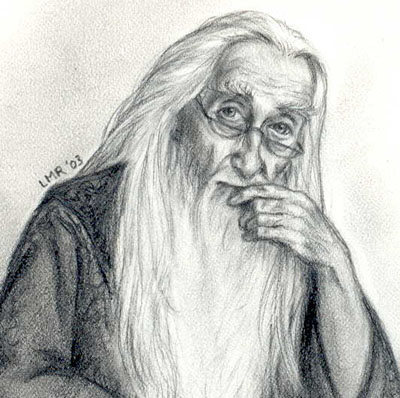
Dumbledore, by Lisa, from
http://www.poudlard.org/fanarts/displayimage.php?album=toprated&cat=6&pos=0
Kristin here–
By now anyone who has not lived in thorough isolation from the media knows that on October 19, during a signing of Harry Potter and the Deathly Hallows at Carnegie Hall, J. K. Rowling revealed that Prof. Albus Percival Wulfric Brian Dumbledore is gay.
At least in her opinion, some might add.
Rowling’s public revelation that she has long considered Dumbledore to be gay came during a question and answer session in which a fan asked, “Did Dumbledore, who believed in the prevailing power of love, ever fall in love himself?” Rowling replied, “My truthful answer to you … I always thought of Dumbledore as gay.” According to mainstream media reports, after a stunned silence the audience burst into a lengthy ovation.
Rowling has made a few additional comments on this subject since then. On October 22 during a press conference in Toronto, she was questioned about how far back her outlook on Dumbledore’s sexual orientation went. She dated it back to the planning stages, “probably before the first book was published” (Harry Potter and the Philospher’s Stone, 1997). She pointed out, “I was writing for seven years before the first book came out.” (The press conference has been posted in two parts on YouTube, here and here. Some stories from reporters covering the event have slightly misquoted Rowling’s statements. My quotations are transcribed from the video.)
Naturally questions about the Dumbledore outing came at regular intervals during the Toronto press session. Initially Rowling commented, “It has certainly never been news to me that a brave and brilliant man could love other men.” Asked about the political ramifications of the outing, Rowling said that she could not comment on that so soon after the fact. “I can’t really answer that. It is what it is. He’s my character, and as my character, I have the right to know what I know about him and say what I say about him.”
But do we want to listen?
Of course, she has the right. The questions that have been raised by many are, should she? If she does, should we accept her statements as true within the universe of the published books?
Whether she should provide additional background for the series is basically a matter of opinion. Some people, many of them children, want more information and think she should.
Salon.com’s Rebecca Traister has posted a thoughtful essay taking the “she shouldn’t” position. She points out one thing that most fevered accounts of the Dumbledore outing have neglected: “Dumbledore’s gayness is one of the pieces of bonus information about her characters that she’s been dispensing steadily since the publication of her magical swan song, ‘Harry Potter and the Deathly Hallows.’”
Certainly at the Carnegie Hall appearance, the Dumbledore question came amidst several that Rowling was asked about the fates or motives of other characters. (The most extensive transcript of that Q&A session is on The Leaky Cauldron.) Nearly all mainstream media reports ignored these in favor of blowing up the gay issue, but just as much information about other characters was revealed, and Rowling has answered similar queries in other Q&A situations.
Traister admits that the fans are the ones asking for such information. “Her abundant generosity with information is surely a response to a vast, insatiable fan base that does not have a high tolerance for never-ending suspense, ambiguity or nuance. As she told the ‘Today’ show’s Meredith Vieira back in July, ‘I’m dealing with a level of obsession in some of my fans that will not rest until they know the middle names of Harry’s great grand-parents.’”
Traister adds, “Rowling naturally wants to provide answers for these heartbroken obsessives who perhaps are too young to know the satisfying pleasures of perpetual yearning and feel that they must must must know how much money Harry makes and whether Luna has kids.” I don’t know about heartbroken, but they certainly are curious.
Traister goes on to argue that Rowling should stop giving out information and ruining readers’ own imaginings about what the author left out. She cites an example of Rowling revealing to a fan what Harry’s Aunt Petunia nearly said to him upon their last parting. According to Rowling, it was “I do know what you’re up against, and I hope it’s OK.” Traister is disappointed: “Oh. That’s too bad. Because in my imagination, Petunia was going to say something much more exciting than that.”
Perhaps in many cases, especially about specific details like this, knowing is less fun than imagining. Still, I’m sure some of Rowling’s revelations are more exciting, or at least more interesting, than what we imagine.
Let’s take one small example, Rowling’s explanation for the name “Dumbledore.” Few readers will imagine anything about it or realize that the word actually means something. I have wondered whether Rowling just liked the sound of the word (which appears in Hardy and Tolkien) or she saw some connection between the headmaster and a bumblebee. She revealed the answer in a radio interview in 1999: “Dumbledore is an old English word meaning bumblebee. Because Albus Dumbledore is very fond of music, I always imagined him as sort of humming to himself a lot.”
That’s charming. I didn’t imagine Dumbledore humming as I read the book. Indeed, I don’t recall any scenes where he is alone (presumably when he hums), given how much of the narration is restricted to Harry’s point-of-view. But I am glad to know this, even if it had to come from the author herself. (In the same interview, by the way, she said, “I kind of see Dumbledore more as a John Gielgud type, you know, quite elderly and – and quite stately.” Perhaps a hint of where the gayness crept in.)
If Rowling were to heed Traister’s plea that she stop dispensing extra-textual information, that would mean we adults, who presumably “know the satisfying pleasures of perpetual yearning,” would get our way and the children wouldn’t. (Of course, not nearly all adults would refrain from asking for more information from Rowling.) I think that’s rather unfair, since these are at bottom children’s books. It was initially surprising how many adults ended up reading them, and there are HP fans of all ages. Still, shouldn’t the target audience take priority?
The video of the Meredith Vieira interview and the transcript of the Carnegie Hall event confirm that many of the questions were requests for more information about the characters. Would we really want the author to refuse each of these? How boring and frustrating for those children if every other answer is, “I really shouldn’t tell you. Just use your imaginations”! They want those “pieces of bonus information about her characters that she’s been dispensing steadily.” As far as I can tell, most or all of the bits of information Rowling has given out have come in response to specific questions from fans. She hasn’t been volunteering them right and left. And apart from the Dumbledore comments, the information she gives out has hardly been flooding the media to such an extent that we can’t avoid it if we wish. Given that Rowling has been answering such questions for months, why did commentators wait until this particular revelation to complain?
Who’s J. K. Rowling to tell us Dumbledore is gay?
Quite apart from there being some people who want this information and others who don’t, there is a more theoretical question. As Jason Mittell puts it in a brief essay on his website, “What does it mean for an author to proclaim such information about a character in an already completed fictional world?”
Mittell would accept that Rowling’s statements about that world would become part of the HP canon as long as the series was still in progress. “But something changes once a series is complete.” He points out that Rowling seems to have known all along that Dumbledore is gay, and yet she never made that explicit. “Does she retain her power to control her fictional world after the books have been closed?”
Does it have to be explicit, or will implicit do? Some, including Rowling, would say that there is a portrayal of Dumbledore’s relationship with Grindelwald that hints at his being gay. At the Toronto press conference, Rowling stated, “It’s in the book. It’s very clear in the book. Absolutely. I think a child will see a friendship, and I think a sensitive adult may well understand that it was an infatuation. I knew it was an infatuation.” I must admit that I didn’t pick up on the clues. Not that I’m insensitive, I hope, but because it would not have occurred to me that a popular mainstream writer would include a prominent gay character. (Associated Press writer Hillel Italie has pointed out a few passages that some may have taken as indications.)
[Added Oct. 29: The November 2 print issue of Entertainment Weekly has the results of an online poll, “Did you suspect Dumbledore was gay? (p. 11). 22% said they did. That’s probably self-selecting, as those who did might be more likely to vote. Still, at least some people did figure it out.]
Putting aside that example, though, much of the other information Rowling has been giving out does concern events that occur after the books’ action or are never referred to in the texts, so Mittell’s question remains.
Mittell contrasts this situation with that of Star Trek, where it has been the fans who “claim their interpretive rights to open up ambiguities and subtext freely,” primarily by writing fanfiction. The situation is different, though, I think, because most fans would not claim that their fics enter into and become part of the canon, even though they may meticulously obey its premises. Rowling seems to be claiming the right to expand the HP canon by her statements as well as by her writing.
(By the way, Rowling also mentioned fanfiction during her answers about Dumbledore at Carnegie Hall. I’ve written on her remarks and that subject on the Frodo Franchise blog.)
One can accept Rowling’s pronouncements about the book series or not. But do those pronouncements carry any greater weight than comments made about the HP world by others?
I am aware that in the 20th Century, the “death of the author” was proclaimed. When I was in graduate school, “intentions” was still sort of a dirty word in analysis. If the work cannot stand entirely by itself, then it has to some degree failed, was the widespread view.
There’s some truth to that, and yet there clearly is a very widespread impulse on the parts of readers and viewers to ask living creators for more. Film scholars read interviews with directors and other filmmakers. Some filmmakers have written about their individual works or their craft in general. David has commented here recently, “Do filmmakers deserve the last word?” As he shows, they can dispense misleading information about their own films. Yet not letting them have the last word doesn’t mean we must ignore all their other words. They often have very interesting things to say.
There are points that could be made in favor of a voluble Rowling.
One could argue that the books are not necessarily closed. Rowling could always write more in this universe. Indeed, she has said she probably will write an encyclopedia on the HP world–though she has cautioned this may not be her next project. A summary of Rowling’s July 24 appearance on the Today Show describes the project, partly in Rowling’s words: “’I suppose I have [started] because the raw material is all in my notes.’ The encyclopedia would include back stories of characters she has already written but had to cut for the sake of the narrative arc (‘I’ve said before that Dean Thomas had a much more interesting history than ever appeared in the books’), as well as details about the characters who survive ‘Deathly Hallows,’ characters who continue to live on in Rowling’s mind in a clearly defined magical world.” Presumably much of the information she has given in answer to questions comes from this mass of material, so it may someday exist in print with her as the author.
In the Toronto press conference Rowling gave further information about possible writing projects within the franchise. She said she would probably not write a prequel for the HP series, though she would not rule it out entirely. Asked about the rumored encyclopedia, she replied that it “would be the way of putting in all the information, the extra information on all these characters.” She adds that the proceeds would go to charity and that “It’s certainly not something I plan on being my next project. I’d like to take a little time from Harry’s world before I go into that.”
Tolkien did something comparable. For nearly two decades after the publication of The Lord of the Rings, he wrote drafts of essays on various characters and events. He seems to have initially intended these as an entire volume of appendices, though later he continued because he just could not seem to stop examining his invented world. The resulting posthumous publications of these texts as edited by his son are not exactly canon—not least because they are unfinished and sometimes contradict each other. But they certainly are treated by scholars and fans as illuminating parts of Tolkien’s created world that are not in the novel. Semi-canon, if you will. Perhaps if Rowling does write down all the nuggets of information that she has been tossing out, publication will anoint them with canonical status at last.
One could also argue that HP is not just a book series but an ongoing franchise or saga. The book series may be finished, but the HP universe is larger than it. Rowling’s outing of Dumbledore and other remarks come when there are two films yet to appear. One of these has already been slightly affected. In the Carnegie Hall Q&A, Rowling related how she scotched a scene in the script where Dumbledore reminiscences romantically about a young lady by passing along a note that the character is gay. Given that the object of Dumbledore’s putative past affections, Grindelwald, will presumably figure in the seventh film, it’s quite possible that Rowling’s statements will affect the portrayal of that relationship. While she is not one of the filmmakers, she scrutinizes the scriptwriting process closely, and whatever makes it into the movies might be considered as canon in some sense.
Finally, one could argue that Rowling’s voice is not simply one among many who might comment on the subject of her books. Setting aside aesthetic theory, for most people in the real world her authority as the author simply is more compelling than anyone else’s. Don’t believe it? What if Stephen King wrote a column announcing that Dumbledore is definitely not gay? (Not that he’s likely to do so.) Would we be inclined to believe him as much as Rowling just because he is also one of the most successful current writers and a fan of the series? I doubt it. What if Pat Robertson preached a sermon stating that Dumbledore is so admirable that he could not possibly be gay? Might we not indignantly counter him by saying, “He is, too. Rowling says so.” It’s the only concrete evidence we have.*
Robertson probably wouldn’t make such a claim. Much of the far right is already up in arms against Rowling. They don’t seem to doubt for a minute her after-the-fact statement that she has written a gay character. They not only believe it but they denounce it as part of some liberal plot to promote homosexuality as normal. For once they’re not far off.
Such claims suggest that we might have political reasons to accept Rowling’s outing of Dumbledore as authoritative—and presumably her remarks about other characters as well. We might want the overall theme of tolerance that is so evident in the series to extend to homosexuality. Clearly Rowling does, too. And she knows what it means. At a signing in Los Angeles a few days before the Carnegie Hall outing, Rowling stated, “I take my inclusion on the banned book list as a massive compliment.”
The Timing of the Revelation
Many comments have been made about the timing of Rowling’s announcement. If she’s so proud of having her books banned, why didn’t she speak up before? Was there a hidden, cynical motive for waiting until all the books were published? Was she trying to avoid losing sales by not revealing Dumbledore’s gayness while the books were still coming out? Was she trying to boost sales of the books after the series’ conclusion by stirring up controversy?
I’ve already argued that the second reason is unlikely. Rowling answered a child’s question on the spur of the moment. (The questions asked by the children in such sessions are pre-screened, but it seems unlikely that the assistants who do the screening convey the questions to Rowling ahead of time.)
How much will sales be boosted now that she has told the public about Dumbledore? This series is such a huge seller that it’s hard to imagine anyone, other than gay men, deciding to buy it solely because Dumbledore has been revealed to be gay. Surely no kids would buy it for that reason. OK, maybe a few liberal parents desiring an uplifting book for their kids might buy it for them.
But we know how many right-wingers there are in this country and how successful they have been at attacking the teaching of science in schools and at demanding that books be removed from library shelves, including the HP series because it “promotes witchcraft.” Surely the outing of Dumbledore in the midst of the series would have cut significantly into the sales for the rest of the books.
I doubt Rowling calculated it that way, but if she did, she was being smart. Possibly, though, her calculations, if any, were as much or more ideological than monetary. She clearly is a liberal, claiming that one major theme of the HP series is tolerance and that another is suspicion of authority.
(For a discussion of these political aspects of the books, see Keith Olbermann’s October 22 Countdown segment on the Dumbledore outing, in transcript or video form.)
Consider what outing Dumbledore after the book series ended implies. There are undoubtedly millions of children in this country whose parents oppose equality for homosexuals. Many of those children now have all seven books lined up on their bedroom shelves, and they may own several HP franchise products, including DVDs. They adore this series. For many the books are probably their favorite cultural artifact in the world. Now picture what would happen if those ultra-conservative parents march in and declare that everything Potter is going in the garbage because it’s immoral, pro-gay propaganda—or less pleasant terms to that effect.
I can imagine three basic reactions.
One, the child will respond, yes, take these terrible books away, they’re bad for me. Ned Flanders’ sons would say that. Maybe a few others would. Such kids are already indoctrinated, and we will just have to hope that they leave home someday and discover more enlightened views.
Two, the child starts crying, arguing, and defending the books. The parents give up and go away. Now this child of ultra-conservative parents has and will likely re-read a book series whose content–at least according to Rowling–runs counter to their parents’ beliefs. A tiny victory for tolerance, repeated in many homes across the land. Perhaps Rowling’s series will help guide such children, if only in a small way, to be less bigoted than their parents. Indeed, there is reason to hope so. Opposition to gay marriage is already less widespread among young evangelicals than among the older generation, with 81% of those above 30 opposed, 76% among those under 30.
Three, the child starts crying, arguing, and defending the books. The parents are adamant and dispose of all the books and paraphernalia. As a result, the child is upset by a homophobic act. Some such children may grow up primed to realize that homophobia is a bad thing. Others will presumably recover and become as intolerant as their parents.
I suppose there might be some way that a child who has already read the books could become even less tolerant of homosexuality as a result of Dumbledore’s turning out to be gay. It’s hard to believe, but maybe it could happen. On the whole, though, Rowling’s revelation creates a win-tie situation. Kids are either influenced for the good or they remain the same. She has smuggled liberal ideas into the heart of the enemy’s camp in a form that will be difficult to eradicate.
How much can a mere book series, along with its attendant films and franchise products, affect society’s attitudes toward something as important as equal rights for homosexuals? It’s hard to say. On rare occasions, books do have a real impact in society. Harriet Beecher Stowe’s 1852 novel Uncle Tom’s Cabin was a major factor in promoting abolitionism, the Civil War, and the freeing of the slaves. Apart from the Bible, it was the best-selling book of the nineteenth century. Perhaps a phenomenally popular liberal author of our own times can use her influence for good as well.
Do pre-teen children really understand what’s going on when Rowling says Dumbledore is gay? Conservatives complain about her choice to do the outing to an audiences of kids. But as Olbermann points out in the segment linked above, the HP books contain death, persecution, betrayal, torture, revenge, and all sorts of dark things that caring parents would likely want to discuss with children as they read the books. In comparison, to complain about having to explain a professor’s sexual preference, particularly when it intrudes only subtly into the plot, seems absurd.
Traister’s Salon.com article contains a cheering anecdote. She says she learned of Rowling’s revelation from a nine-year-old friend at a wedding. The child “exuberantly announced, ‘Dumbledore is gay!'” Traister asked whether she was surprised by this, and the reply was, “Well, I always thought he loved McGonnagall, but I guess he only loved her like a sister.” If only all reactions to the news could be so sensible.
[Added Oct 30: Today’s Star Bulletin (Hawaii) contains an account of three unflappable fans who attended the Carnegie Hall signing and loved it. A photograph taken by the mother of one of them provides the first image I’ve seen of the event.]
*A less prominent figure, John Mark Reynolds, writing on a Christian site, The Scriptorium, makes exactly this claim in his “Dumbledore Is Not Gay: Taking Stories More Seriously Than the Author.” He argues his case in comparable terms to Mittell’s position that the author has no power to affect a book’s content once it has been published.
Scribble, scribble, scribble
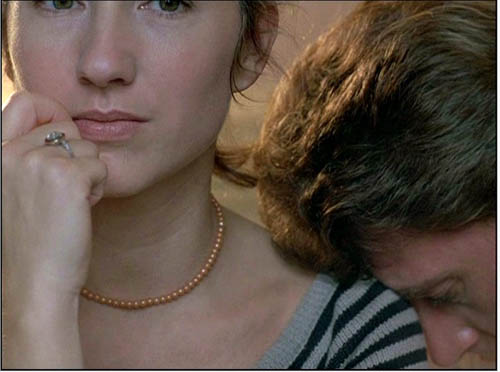
Detective (Godard, 1985).
Another damned, thick, square book! Always scribble, scribble, scribble, eh, Mr. Gibbon?
William Henry, Duke of Gloucester, 1781.
David here:
Kristin kept the blogfires burning while I traveled last week and did UW duties this one. I had a great time at the University of Georgia in Athens (but didn’t see Stipe) and at Emory in Atlanta (but didn’t see Scarlett). At both places I met sharp, energetic students and faculty. I have a couple of blog entries backlogged for posting, but now recent items relating to publications get the pole position.
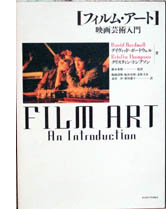 First, a Japanese translation of our Film Art: An Introduction has just appeared. It’s a very handsome version of the seventh edition, rendered by Fujiki Hideaki and Kitamura Hiroshi. We’re grateful to them and to Nagoya University Press for publishing it.
First, a Japanese translation of our Film Art: An Introduction has just appeared. It’s a very handsome version of the seventh edition, rendered by Fujiki Hideaki and Kitamura Hiroshi. We’re grateful to them and to Nagoya University Press for publishing it.
Second, the University of California Press is having a big sale on many outstanding media titles, from Richard Abel’s books on French silent cinema and André Bazin’s classics of film theory to Michele Hilmes’ study of NBC television and Mike Barrier’s new Disney biography, The Animated Man. To get the discount you must sign up for an e-newsletter, but it’s not intrusive.
Among the books of mine on sale, the biggest bargain is the hardcover edition of Figures Traced in Light (2005), originally priced at $65, now going for $7.95 plus postage. (No, apparently I don’t get the full-price royalties.) You can find this item here. There are also paperback copies of Figures (going for $12.95) and of The Way Hollywood Tells It ($15.95). If you’re inclined, hurry: the sale ends on 31 October.
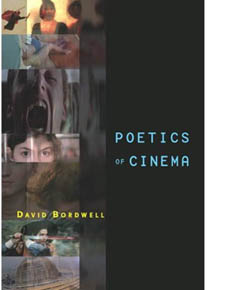 The biggest news, though, is that I just got my author’s copies of Poetics of Cinema, published last week. For a while Amazon was telling some people who pre-ordered it that copies won’t be available until 27 December, but now, despite what it says here, the book seems ready to ship.
The biggest news, though, is that I just got my author’s copies of Poetics of Cinema, published last week. For a while Amazon was telling some people who pre-ordered it that copies won’t be available until 27 December, but now, despite what it says here, the book seems ready to ship.
Bad news first. Poetics of Cinema is priced at $45 in paperback, with no sellers I know offering it at discount. Go ahead, say it: Very expensive. If you haven’t published a book, you may not know that authors have no say in the pricing of their work. Publishers would never set a price or price ceiling in a contract, and calculations about pricing are based on many factors, including what comparable books sell for. A high cost isn’t my preference, of course; every writer wants to reach as many readers as possible. But unless you blog or self-publish your work, the publisher sets the price.
There are some good reasons for the cost. Running to 500 fairly dense pages and containing over 500 photographs, Poetics of Cinema was a complicated book to produce. I peddled it to other publishers, but they ruled it out as too whopping an investment for them. So Routledge has priced it along lines of comparable books, reckoning in the size of the likely audience (I hope, more than 118.3 readers). I have to thank Bill Germano, then Publishing Director at Routledge, for taking a chance on this project.
From age fifteen or so I’ve been a compulsive writer. Scribble, scribble, scribble. I’ve been at work on one book or another for over thirty years. I’ve got several projects in mind for my next effort, but I’ve held back committing. Is there any point in publishing more books, at least as books?
I mean this as a serious question. Would it have made any difference to me or my readers if Poetics of Cinema appeared as pdfs, available at a price considerably less than $45? Wouldn’t I find more readers? What about variable pricing? If Radiohead can do it, why can’t I? Somebody in film studies should try putting a digital book for sale online; maybe I will. But for a few years at least, this last baggy monster will be available only in dead-tree format.
Poetics: Some puzzles


Gentlemen Marry Brunettes (Richard Sale, 1955).
If you’ve read this far, you may be interested in what the book is about. Most basically, it’s predicated on the belief that we make progress in research by asking questions. Some questions are too deep to be answered—call them mysteries—but others can be answered with a fair degree of precision and reliability. We can turn mysteries into puzzles and puzzles into plausible answers.
Here’s a fairly common sort of composition in Hollywood cinema of the 1940s. This shot from The Killers (1946) displays the sort of steep depth I’ve talked about at various points on this blog and in my other books.
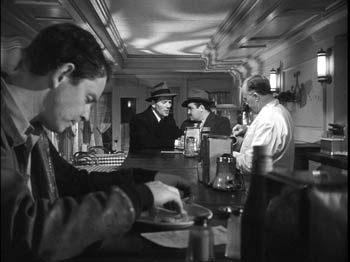
But now here’s an equally tense confrontation at a counter, from Bad Day at Black Rock (1955), made in early CinemaScope.
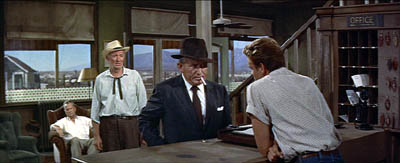
It doesn’t look much like the 1940s shot. The characters stand far from us, and the figure in the foreground doesn’t loom over the background. The shot is more open, the composition more porous. And unlike The Killers, Bad Day doesn’t contain close-ups of the actors in any scenes.
So questions come to mind. Did John Sturges have to stage the scene in Bad Day this way? Did other filmmakers resort to the same choice? What factors created pressures toward this more spacious format? Could more resourceful filmmakers have done something different? And given that such shots are rare today, what changes made it possible for filmmakers in later years to create the tight anamorphic widescreen close-ups we have now (as here in Cellular)?
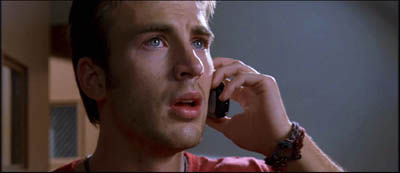
Despite all that has been written about CinemaScope and other early widescreen processes, no one has explored, shot by shot, what staging options were used by filmmakers. A chapter in Poetics of Cinema called “CinemaScope: The Modern Miracle You See Without Glasses” tries to show how filmmakers used the new format to tell their stories. This led them, I propose, to experiment with some staging strategies that, surprisingly, had precedents as far back as the 1910s.
Take another instance. We’re all familiar with recent films that present alternative futures, like Run Lola Run. A story line runs along and then is interrupted, and we switch to the same characters living a different storyline in a parallel universe. The emergence of such “forking path” movies arouses my curiosity. How do they work? How do they make their alternative-reality stories intelligible to the audience? How is it that we’re able to understand them? (After all, the notion of an infinite number of alternative universes to ours is pretty hard to get your head around.) Are such stories a brand-new innovation, or do they have precedents? (Clue: Remember A Christmas Carol?) Why do we see a cluster of these emerging in recent filmmaking?
I tackle these questions in another essay, called “Film Futures.” There I look at several such movies and try to spell out the tacit rules that filmmakers follow and that audiences pick up on. While this story format probably doesn’t constitute a genre, it does obey certain conventions, and I try to chart those. Some films also make some clever innovations in the format, which I also try to trace. The essay as well suggests how the conventions are handled differently in mass-market films like Sliding Doors and in art films like Kieślowski’s Blind Chance.
These two essays, along with the others in the book, try to explain and illustrate an approach to film studies I call film poetics. At bottom, this is an effort to explain why films are designed the way they are: how filmmakers have made certain choices in order to shape our response to their films. How do movies work? How do movies work on us?
Poetics: The project
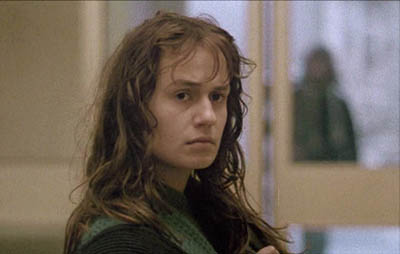
Vagabond (Varda, 1985).
As a kind of reverse engineering, film poetics looks at both structure and texture. I argue that we ought to study how films are constructed architecturally, as revealed for instance in plot structure or narration. Poetics also concentrates on stylistic patterning, the way filmmakers organize the techniques available to the medium. Poetics traditionally deals as well with thematics, the subjects and ideas that are mobilized by filmmakers and reworked by large-scale form and cinematic style.
Put it this way: I want to know how filmmakers have confronted problems set by others, or created problems for themselves to solve. I want to know how they draw on the past to borrow or modify or reject creative strategies. I want to know filmmakers’ secrets, including the ones they don’t know they know. And I want to know how all this creative activity is shaped to the uptake of spectators in different times and places.
Some of what I’ve written on this blog could illustrate how the poetics-driven perspective works in particular cases. The book offers more such instances, probed in more detail than is possible here. Using a comparative method, I also trace out some general principles of film form and style as they have developed over history.
The book consists of fifteen essays. Some have been published before; those have been revised for this collection. Other essays are newly written. After a somewhat polemical introduction, the first part concentrates on some theoretical problems. The anchoring essay offers a general introduction to the idea of a film poetics, with several examples. (An earlier version is on pdfs here.) In the same essay, I float a model of how film viewers respond to various aspects of films. I distinguish activities of perception, comprehension, and appropriation, and I suggest that a cognitive perspective sheds light on them.
Part I also contains an essay considering how cinematic conventions work. A poetics-based approach will spend a lot of time on norms, traditions, and received routines, for these are often the basis of filmmakers’ creative choices. This essay argues that some conventions are local and require a lot of cultural knowledge, while others are cross-cultural, compelling us to study why certain cinematic strategies seem to crop up across the world.
The second part of Poetics of Cinema considers narrative, one of the most common ways in which films are organized to affect viewers. I wrote a new essay to launch this section, a wide-ranging study called “Three Dimensions of Film Narrative.” The three dimensions I consider are narration, plot structure, and the narrative world. The essay considers how each of these shapes our understanding of a film’s story. This essay ends with a discussion called “Narrators, Implied Authors, and Other Superfluities.”
Some more tightly-focused pieces follow. One is devoted to forking-path plots. Another concentrates on an odd question: What role does forgetting play in our watching a film? Cognitive theory can offer some answers, and I take Mildred Pierce as an example. There’s an update of an essay that has been something of a golden oldie in film courses, “The Art Cinema as a Mode of Film Practice.” In a supplement to that piece I suggest some new avenues of inquiry and draw on more examples, notably Varda’s Vagabond (Sans toit ni loi).
The longest piece in Part II is devoted to what I call network narratives. Prototypes of this would be Grand Hotel, Short Cuts, Crash, and Babel. This essay tries to show how a poetics of cinema shed light on this format, currently a very popular one. When I started looking at these movies, I was surprised to discover how many filmmaking traditions work in this vein; I append a filmography with nearly 250 items, and today I could update it with several more. (1) I consider how this option has developed distinctive strategies of narration, plotting, and worldmaking. I also survey some common themes running across network tales, such as the role of chance and fate. The essay finishes with more in-depth analyses of four films: Altman’s Nashville, Iosseliani’s Favoris de la lune, Anderson’s Magnolia, and Jean-Claude Guiget’s Les Passagers.
Poetics: More problems
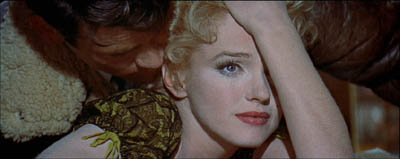
Bus Stop (Logan, 1955).
Part III moves from questions of narrative to questions of film style, no stranger to this blog. The opening essay is a tribute to Andrew Sarris that appraises his role in making readers of my generation style-conscious. It’s the most personal piece in the book. There follows a study of Robert Reinert, a director in the German silent cinema who might have become much better known if his quite demented Nerven and Opium had been as widely seen as Caligari. The essay “Who Blinked First?” considers how our reaction to films is affected by the ways in which actors use their eyes, including how and when they blink. Big deal, huh? Actually, yes.
The monster essay in this section is the CinemaScope piece, of which I’ve given versions in lecture form over the last couple of years. I argue that some directors responded to the new widescreen technology by adapting certain norms of staging and shooting to the new format, while other filmmakers moved in more adventurous directions. The piece uses the model of problem/solution as a way to understand stylistic continuity and change, a framework I’ve floated in On the History of Film Style as well.
The last four studies in Part III are devoted to style in Asian cinema. There are two essays on Japanese film of the 1920s and 1930s, both expanded somewhat from their original versions. There I argue that we can see Japanese directors as building upon, as well as adventurously departing from, stylistic norms shared by most filmmaking countries of the period. This brace of essays fills out some ideas that I fielded in Ozu and the Poetics of Cinema, and they should appeal to that growing body of viewers who have developed a passion for Naruse Mikio and Uchida Tomio. It’s gratifying that several of the films I discuss, which I had to study in archives, are now circulating in touring programs.
Poetics of Cinema concludes with two studies of Hong Kong film, one surveying the stylistic tactics by which that very lively tradition excites its audience, the other analyzing the unique innovations of King Hu. The articles are companion pieces to Planet Hong Kong.
Poetics: The mysteries
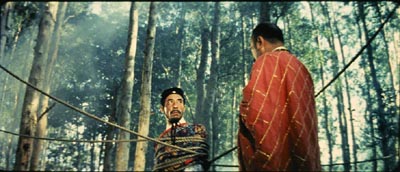
A Touch of Zen (King Hu, 1970).
As an approach to answering questions about cinema, poetics blends history, criticism, and theory. It requires that we do research into the artistic history of film, looking at styles, genres, narrative modes, and other traditions. It asks for close analysis and interpretation of films. At the same time, it asks broader questions about what principles govern narrative, stylistic patterning, and the like. I’d say it obliges a historian to concentrate on aesthetics; it makes criticism more historical and theoretical; it ties theory to concrete historical conditions and the fine-grain workings of individual films.
Kenneth Burke used to say that you could get a sense of a book by looking at its first and last sentences. My book’s first essay opens this way:
Sometimes our routines seem transparent, and we forget that they have a history.
I think that this captures my concern to look closely at familiar things in film and try to make their principles a little more evident. Yet in trying to make filmmakers’ choices explicit and tracing out the principles undergirding how we make sense of movies, I’m sometimes criticized for simply stating common sense. Poetics can look bland alongside the skywriting swoops of most academic film theory. But skywriting is blurry and dissolves while you look at it. By contrast, clearly setting out some basics of filmic construction and comprehension offers a firmer place to start answering questions about how movies work and work on us.
Poetics tries to produce concrete, approximately true claims about cinema. Most film theory operates as an application, borrowing big theories of culture, identity, nationhood, and the like and then mapping them onto films. The results are usually thin. It seems to me that most film theory today is not carefully thought through or persuasively argued. For examples, see my essay in Post-Theory, the last chapter of Figures, and my comments here and here on this site.
In trying to establish reliable knowledge about cinema, we won’t answer every question and we will make false steps, but we can make progress. Film poetics is one way we film enthusiasts can join that tradition of rational and empirical inquiry which remains our most dependable path to knowledge. My introduction, though peppered with some pokes at Big Theory, has the serious purpose of making a plea for film scholars to join that tradition.
The final line of the book concludes the essay on King Hu:
The mainstream [Hong Kong] style has given us many beautiful and stirring films, but Hu’s eccentric explorations evoke something that other directors’ works seldom arouse: a sense that extraordinary physical achievement, if caught through precisely adjusted imperfections, becomes marvelous.
To get the full point you need to read the essay, but what should come through here is my concern to highlight filmmakers’ originality when I find it, and to locate it by means of a comparative method. In addition, I hope that what comes through is an appreciation of the sheer exhilaration we feel when a filmmaker has made the right, bold choice. A poetics-based approach probably can’t fully explain this feeling—it may fall under the heading of mysteries rather than puzzles—but at least it can reveal how some forces contribute to it.
My summary, and the size of the book, may leave the impression that I think that I’ve answered these questions fully. Of course I don’t. I try only to make some progress, realizing that offering answers is also an invitation to disagree, to refine the questions and tackle new ones. Nor do I think that these are the only questions that matter. We’re just starting to understand how films work and work on us, and there are a great many areas we haven’t charted. (Performance, to take a big one.) We have to start somewhere, though. I’d hope that by posing some questions and proposing some answers, Poetics of Cinema offers fruitful points of departure.
(1) Some candidates are 25 Fireman Street (1973, Hungary, István Szabó), Feast of Love (2007, US, Robert Benton), Continental—A Film without Guns (2007, Canada/ Stephane Lafleur), The Edge of Heaven (2007, Germany/ Turkey, Fatih Akin), Unfinished Stories (2007, Iran, Pourya Azarbayjani), God Man Dog (2007, Taiwan, Singing Chen [Chen Hsin-hsuan]), A Century’s End (2000, Korea, Song Neung-han), and Why Did I Get Married? (2007, US Tyler Perry).
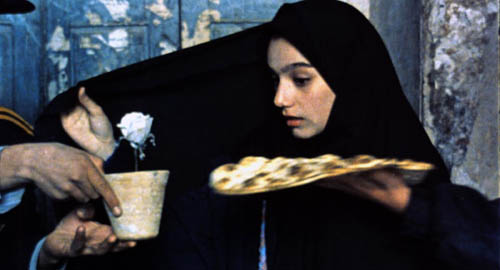
A Moment of Innocence (Mohsen Makhmalbaf, 1996).
I broke everything new again
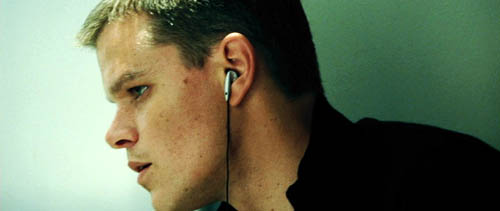
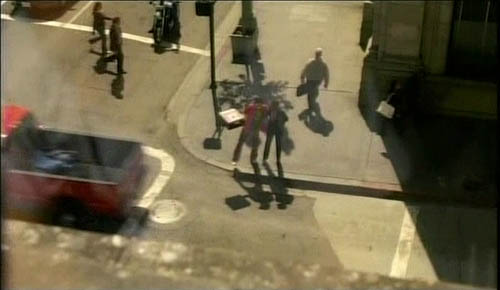
DB here:
Today some notes about cinematic storytelling in two trilogies, one long and one lasting only ninety seconds.
Extreme ways are back again
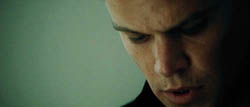
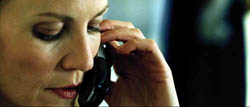
Yes, one more entry on The Bourne Ultimatum, which I thought I was done with. But alert reader Damian Arlyn sent me an email proposing an ingenious explanation for Ultimatum‘s repetition of a scene from The Bourne Supremacy. (Something like his idea is also suggested here and here.)
After yet another viewing, I agree: That scene is the same piece of plot action, replayed in a new context. This makes the film’s structure more interesting than I’d thought in my entries here and here.
Continue at the risk of spoilers.
At the climax of Supremacy, Jason kills Marie’s assassin in a traffic-clogged tunnel. He then visits the daughter of the Russian couple he murdered during his first CIA mission. The epilogue of Supremacy takes place in New York City. Jason calls Pamela Landy while he watches her in her office from an opposite building. Apparently as a token of thanks, Pam tells him his real name and adds his birthdate: “4/15/71.” Supremacy ends with him striding off with a shoulder bag and vanishing into the Manhattan crowd.
The phone conversation is replayed in Ultimatum. Bourne and Pam are in the same clothes, her office furniture is the same, what we hear of the dialogue is identical. But now the sinister Deputy Director Noah Vosen is monitoring the call, so at moments we see the scene refracted through his and his technicians’ eavesdropping. Just as important, Pam’s report of Jason’s birthdate turns out to be inaccurate. She has given him a coded reference: the building where he received his initiation into the assassin’s life is 415 71st Street. He heads there to confront Dr. Albert Hirsch, his Svengali. The script has played fair with us on this: We’ve had opportunities to glimpse Bourne’s real birthdate (9/13/70) on the paperwork Pam flicks through in an earlier scene.
You could argue that this replay dilutes the emotional force of the Supremacy scene. Instead of giving Jason back his identity, a gesture of emotional bonding, Pam presents yet another clue of the sort that has linked Bourne’s quest throughout the film. Feeling, one might say, has been replaced by espionage-movie plot mechanics. But I think that the device is more interesting than that. For one thing, if you’ve seen the first film, there will still be the lingering memory of your sense of Pam’s sincerity and Jason’s gratitude. Just as intriguing are the structural consequences.
If we imagine the second and third installments in the franchise as presenting one long story, the original phone conversation in Supremacy comes after most of the events we see in Ultimatum. Ultimatum begins with Bourne in Moscow, limping as he was upon leaving the daughter’s apartment and still spattered with blood from the tunnel chase. That is, the prologue of this film carries on continuously from the end of the second film’s climax, but long before its epilogue in New York.
After a title announcing, “Six Weeks Later,” Bourne’s European globetrotting in Ultimatum begins. Meanwhile, back at the CIA Pam explains that Jason had gone to Moscow to find the daughter. The bulk of the film carries him to Paris, London, Madrid, and Tangier, all the while trailed by the agency. The final clue brings Bourne to Manhattan. Only then does he visit the building opposite the CIA station and make the call we’ve already, and incompletely, seen at the close of the second film. This new version of the scene initiates the final section of Supremacy, as Bourne sends the agents on a false trail, breaks into Noah’s office to grab incriminating documents (which he tucks into that shoulder bag), and makes his way to 71st Street and his fateful confrontation with Hirsch.
So the two films mesh intriguingly. Most of film 3 takes place just before the end of film 2, making the epilogue of 2 launch the climax of 3. This is a step beyond the more common sort of flashback to founding events in the story chronology, the tactic used at the start of Indiana Jones and the Last Crusade and The Lord of the Rings: The Return of the King. In these films, the jump back in time is more obviously signposted than in the Bourne movies.
The screenwriters Tony Gilroy, Scott Z. Burns, George Nolfi, and Tom Stoppard (uncredited) have made a clever and welcome innovation that I didn’t appreciate at first. I’m happy to finally understand it, though, because it fits into a trend I discussed in The Way Hollywood Tells It and an earlier entry. Some filmmakers today create looping, back-and-fill story lines that tease us into watching the movie over and over on DVD, à la Memento and Donnie Darko. There are still some Bourne questions lingering in my mind, so I guess Universal can sign me up as a DVD customer. . . sigh.
I’ve seen so much in so many places
Speaking of The Way, there I also noted the growth in contemporary cinema of what I call network narratives, or what Variety calls criss-crossers. These are films with several protagonists connected by friendship, kinship, or accident. The characters pursue different goals but as the film develops their actions affect one another. The classic examples are Nashville, Short Cuts, and Magnolia, but in writing about this strategy for my collection Poetics of Cinema, I found over a hundred such movies.
This week I noticed that a trio of TV commercials from Liberty Mutual Insurance seems to be influenced by this format. Each of these “Responsibility” ads compresses network principles into thirty seconds, while also adding a Twilight-Zoneish time warp. You can watch the ads here.
Each commercial begins by showing a woman and a pizza-delivery kid at a street corner. She thrusts out her arm to keep him from striding into the path of a car.
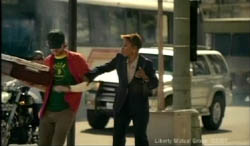
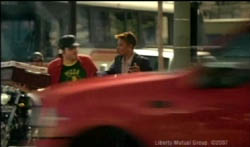
Somebody sees the woman’s act of kindness, and then that person is shown doing something kind. Someone else sees the second person and then is shown being kind, and so on. For example, in one variant a man across the street notices the woman and the delivery boy, and then he helps a lady with a baby get off a bus. He is watched by a man at the bus stop, who then is shown helping someone else. Like a benign contagion, solicitude spreads from person to person.
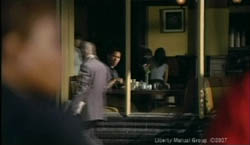
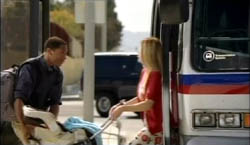
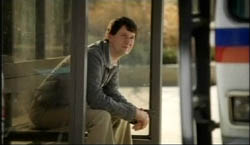
So we have a very slight set of connections: A is seen by B who is seen by C and so on. This patterning seems comparable to the shifting plotlines and viewpoints we find in some network films, with each character connected by accident and spatial proximity. The framings orient us by overlapping bits of space; the pizza boy’s red jacket gives us a landmark in the foreground, as does the bus in the later shot.
More interestingly, all three ads start with the same situation, the woman and the pizza boy, but they move on to different B’s, C’s, etc. In the variant I just mentioned, the man watching is sitting across the street. In another one, the woman’s act of responsibility is observed by the biker behind her, and he becomes B in a new chain of connections, setting out a traffic cone to warn drivers.
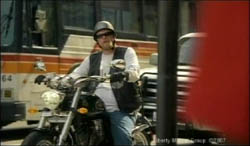
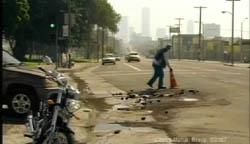
The biker is visible in the first shot of the other ads (see above), but there he plays no role. In the third ad, a man watching from above sees the pizza-boy mishap. (His point-of-view shot is at the top of this post.)
So, as with Jason’s and Pam’s conversation in Bourne, we have a narrative node or pivot that is contextualized differently in another film. What allows this to work, I suggest, is a piece of our social intelligence–our understanding that chance can connect people—plus our cultural experience with storytelling, particularly network narratives. The oddest twist, though, comes at the end of each ad, which like the Bourne trilogy offers an interesting repetition.
Each string of actions ends with the woman we saw at the beginning observing someone else’s act of kindness. For example, in one ad she sees a man at an airport baggage conveyor help an old man snag his bag.
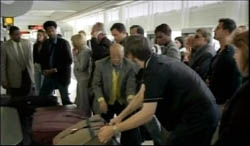
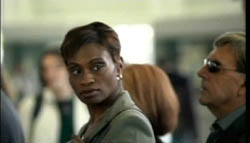
And then once more we see her halt the pizza-delivery kid. So each ad gives us a network something like this: A-B-C-D-…-A. The action moves in a circle, back to the woman as a witness, and then back to her at the pedestrian crossing, once more protecting the delivery boy.
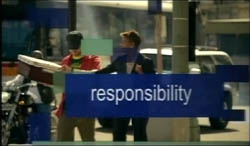
Huh? The ending of the ad suggests that by seeing another person acting responsibly, the woman is more inclined to warn the boy. But that act, with the same boy, was what set off the chain of charity in the first place. In strictly realistic terms, we’ve got a sort of möbius strip (no, not a Moby strip), where the head is glued to the tail and the whole cycle is in a twist.
Well, consider the filmmakers’ problem. How could you end it otherwise? The cascade of charity could go on indefinitely, which is not a plausible scenario for a thirty-second spot. Instead, the swallowing-the-tail tactic brings the pattern to a satisfying conclusion, while providing an event that can be the jumping-off point for another cycle in another ad. The last shot of any of the ads is the first shot of any of the others. You can enjoy the whole cycle as a mini-movie that jumps back in time to the original act of kindness at the corner.
Of course the pattern isn’t meant to be realistic. The message is that small acts can make a difference, and that Liberty Mutual tries to live up to an ideal of responsibility in its business. The themes are presented in an oblique, rather poetic story that suggests that kindness is catching and that even as strangers we are bound to help one another. Significantly, the act that’s presented through multiple replays is the most consequential: the woman is in effect saving the pizza boy’s life.
Both the Bourne movies and “Responsibility” show that studying film narrative is endlessly interesting, and storytellers can be quite creative. There’s always room in life for this.
Legacies
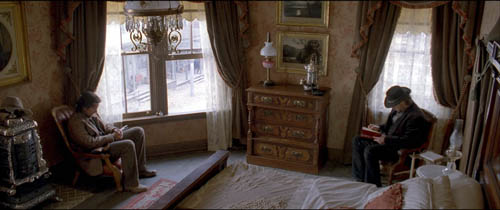
DB here:
By now James Mangold’s 3:10 to Yuma has had its critics’ screenings and sneak previews. It’s due to open this weekend. The reviews are already in, and they’re very admiring.
Back in June, I saw an early version as a guest of the filmmaker and I visited a mixing session, which I chronicled in another entry. I was reluctant to write about the film in the sort of detail I like, because I wasn’t seeing the absolutely final version and because it would involve giving away a lot of the plot.
I still won’t offer you an orthodox review of the film, which I look forward to seeing this weekend in its final theatrical form. Instead, I’ll use the film’s release as an occasion to reflect on Mangold’s work, on his approach to filmmaking, and on some general issues about contemporary Hollywood.
An intimidating legacy
It seems to me that one problem facing contemporary American filmmakers is their overwhelming awareness of the legacy of the classic studio era. They suffer from belatedness. In The Way Hollywood Tells It, I argue that this is a relatively recent development, and it offers an important clue to why today’s ambitious US cinema looks and sounds as it does.
In the classic years, there was asymmetrical information among film professionals. Filmmakers outside the US were very aware of Hollywood cinema because of the industry’s global reach. French and German filmmakers could easily watch what American cinema was up to. Soviet filmmakers studied Hollywood imports, as did Japanese directors and screenwriters. Ozu knew the work of Chaplin, Lubitsch, and Lloyd, and he greatly admired John Ford. But US filmmakers were largely ignorant of or indifferent to foreign cinemas. True, a handful of influential films like Variety (1925) and Potemkin (1925) made an impact on Hollywood, but with the coming of sound and World War II, Hollywood filmmakers were cut off from foreign influences almost completely. I doubt that Lubitsch or Ford ever heard of Ozu.
Moreover, US directors didn’t have access to their own tradition. Before television and video, it was very difficult to see old American films anywhere. A few revival houses might play older titles, but even the Museum of Modern Art didn’t afford aspiring film directors a chance to immerse themselves in the Hollywood tradition. Orson Welles was considered unusual when he prepared for Citizen Kane by studying Stagecoach. Did Ford or Curtiz or Minnelli even rewatch their own films?
With no broad or consistent access to their own film heritage, American directors from the 1920s to the 1960s relied on their ingrained craft habits. What they took from others was so thoroughly assimilated, so deep in their bones, that it posed no problems of rivalry or influence. The homage or pastiche was largely unknown. It took a rare director like Preston Sturges to pay somewhat caustic respects to Hollywood’s past by casting Harold Lloyd in Mad Wednesday (1947), which begins with a clip from The Freshman. (So Soderbergh’s use of Poor Cow in The Limey has at least one predecessor.)
Things changed for directors who grew up in the 1950s and 1960s. Studios sold their back libraries to TV, and so from 1954 on, you could see classics in syndication and network broadcast. New Yorkers could steep themselves in classic films on WOR’s Million-Dollar Movie, which sometimes ran the same title five nights in a row. There were also campus film societies and in the major cities a few repertory cinemas. The Scorsese generation grew up feeding at this banquet table of classic cinema.
In the following years, cable television, videocassettes, and eventually DVDs made even more of the American cinema’s heritage easily available. We take it for granted that we can sit down and gorge ourselves on Astaire-Rogers musicals or B-horror movies whenever we want. Granted, significant areas of film history are still terra incognita, and silent cinema, documentary, and the avant-garde are poorly served on home video. Nonetheless, we can explore Hollywood’s genres, styles, periods, and filmmakers’ work more thoroughly than ever before. Since the 1970s, the young American filmmaker faces a new sort of challenge: Now fully aware of a great tradition, how can one keep from being awed and paralyzed by it? How can a filmmaker do something original?
I don’t suggest that filmmakers have decided their course with cold calculation. More likely, their temperaments and circumstances will spontaneously push them in several different directions. Some directors, notably Peckinpah and Altman, tried to criticize the Hollywood tradition. Most tried simply to sustain it, playing by the rules but updating the look and feel to contemporary tastes. This is what we find in today’s romantic comedy, teenage comedy, horror film, action picture, and other programmers.
More ambitious filmmakers have tried to extend and deepen the tradition. The chief example I offer in The Way is Cameron Crowe’s Jerry Maguire, but this strategy also informs The Godfather, American Graffiti, Jaws, and many other movies we value. I also think that new story formats like network narratives and richly-realized story worlds have become creative extensions of the possibilities latent in classical filmmaking.
James Mangold’s career, from Heavy onward, follows this option, though with little fanfare. He avoids knowingness. He doesn’t fill his movies with in-jokes, citations, or homages. Instead, he shows the continuity between one vein of classical cinema and one strength of indie film by concentrating on character development and nuances of performance. In an industry that demands one-liners and catch-phrases sprinkled through a script, Mangold offers the mature appeal of writing grounded in psychological revelation. In a cinema that valorizes the one-sheet and special effects and directorial flourishes, he begins by collaborating with his actors. He is, we might say, following in the steps of Elia Kazan and George Cukor.
Sandy
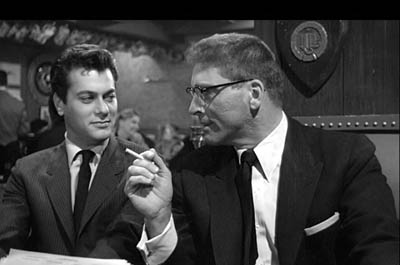
By his own account, Mangold awakened to these strengths during his formative years at Cal Arts, where he studied with Alexander Mackendrick. Mackendrick directed some of the best British films of the 1940s and 1950s, but today he is best known for Sweet Smell of Success.
Seeing it again, I was struck by the ways that it looks toward today’s independent cinema. It offers a stinging portrait of what we’d now call infotainment, showing how a venal publicist curries favor with a monstrously powerful gossip columnist. It’s not hard to recognize a Broadway version of our own mediascape, in which Larry King, Oprah, and tmz.com anoint celebrities and publicists besiege them for airtime. While at times the dialogue gets a little didactic (Clifford Odets did the screenplay), the plotting is superb. Across a night, a day, and another night, intricate schemes of humiliation and aggression play out in machine-gun talk and dizzying mind games. It’s like a Ben Jonson play updated to Times Square, where greed and malice have swollen to grandiose proportions, and shysters run their spite and bravado on sheer cutthroat adrenalin.
Sweet Smell was shot in Manhattan, and James Wong Howe innovated with his voluptuous location cinematography. “I love this dirty city,” one character says, and Wong Howe makes us love it too, especially at night.
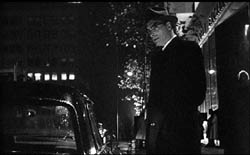
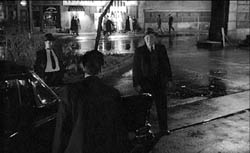
Today major stars use indie projects to break with their official personas, and the same thing happens in Mackendrick’s film. Burt Lancaster, who had played flawed but honorable heroes, portrayed the columnist J. J. Hunsecker with savage relish. “My right hand hasn’t seen my left hand in thirty years,” he remarks. Tony Curtis, who would go on to become a fine light comedian, plays Sidney Falco as a baby-faced predator, what Hunsecker calls “a cookie full of arsenic.” Falco is sunk in petty corruption, ready to trade his girlfriend’s sexual favors for a notice in a hack’s column. Hunsecker and Falco, host and parasite, dominator and instrument, are inherently at odds, then in a breathtaking scene they double-team to break the will of a decent young couple. There are no heroes. Nor, as Mangold points out in his Afterword to the published screenplay, do we find any of that “redemption” that today’s producers demand in order to brighten a bleak story line.
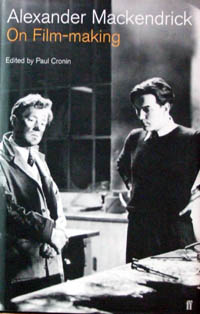 Mackendrick must have been a wonderful teacher. On Film-Making, Paul Cronin’s published collection of his course notes, sketches, and handouts, forms one of our finest records of a director’s conception of his art and craft. Offering a sharp idea on every page, the book should sit on the same shelf with Nizhny’s Lessons with Eisenstein.
Mackendrick must have been a wonderful teacher. On Film-Making, Paul Cronin’s published collection of his course notes, sketches, and handouts, forms one of our finest records of a director’s conception of his art and craft. Offering a sharp idea on every page, the book should sit on the same shelf with Nizhny’s Lessons with Eisenstein.
Mangold became a willing apprentice to Mackendrick. “He taught me more craft than I could articulate, but beyond that, he showed me how hard one had to work to make even a decent film.” (1) Mangold’s afterword to the Sweet Smell screenplay offers a precise dissection of the first twenty minutes. He shows how the script and Mackendrick’s direction prepare us for Hunsecker’s entrance with the utmost economy. Mangold traces out how five of Mackendrick’s dramaturgical rules, such as “A character who is intelligent and dramatically interesting THINKS AHEAD,” are obeyed in the film’s first few minutes. The result is a taut character-driven drama, operating securely within Hollywood construction while opening up a sewer in a very un-Hollywood way. Surely Sandy Mackendrick’s boldness helped Mangold find his own way among the choices available to his generation.
Movies for grownups
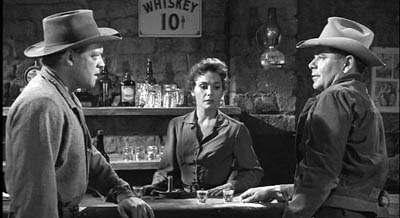
Mangold has often mentioned his love for classic Westerns; on the DVD commentary for Cop Land he admits that he wanted it to blend the western with the modern crime film. But why Delmer Daves’ 3:10 to Yuma?
The Searchers, Rio Bravo, and The Man Who Shot Liberty Valance were objects of veneration for directors of the Bogdanovich/ Scorsese/ Walter Hill generation, while Yuma seemed to be a more run-of-the-mill programmer. To American critics in the grips of the auteur theory, Delmer Daves sat low in the canon, and Glenn Ford and Van Heflin offered little of the star wattage yielded by John Wayne, James Stewart, and Dean Martin. In retrospect, though, I think that you can see what led Mangold to admire the movie.
For one thing, it’s a close-quarters personal drama. It doesn’t try for the mythic resonance of Shane or The Searchers or Liberty Valance, and it doesn’t relax into male camaraderie as Rio Bravo does. The early Yuma simply pits two sharply different men against one another. Ben Wade is a robber and killer who is so self-assured that he can afford to be courteous and gentle on nearly every occasion. Dan Evans is a farmer so beaten down by bad weather, bad luck, and loss of faith in himself that he takes the job of escorting the killer to the train depot.
That dark glower that made Glenn Ford perfect for Gilda and The Big Heat slips easily into the soft-spoken arrogance of Wade. His self-assurance makes it easy for him to play on all of Evans’ doubts and anxieties. In counterpoint, Van Heflin gives us a man wracked by inadequacy and desperation; his flashes of aggression only betray his fears. In the end, his courage is born not of self-confidence but of sheer doggedness and a dose of aggrieved envy. He has taken a job, he needs the money to provide for his family, and, at bottom, it’s not right that a man like Wade should flourish while Evans and his kind scrape by. As in Sweet Smell of Success, the drama is chiefly psychological rather than physical, and the protagonist is far from perfect.
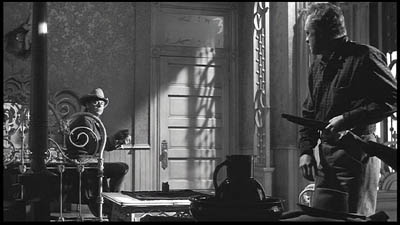
Daves shows the struggle without cinematic flourishes, in staging and shooting as terse as the prose in Elmore Leonard’s original story. Deep-focus images and dynamic compositions maintain psychological pressure, and as ever in Hollywood films, undercurrents are traced in postures and looks, as when Wade in effect takes over Evans’ role as father at the dinner table.
One more factor, a more subliminal one, may have attracted Mangold to Daves’ western. 3:10 to Yuma was released in 1957, about two months after Sweet Smell of Success. Both belong to a broader trend toward self-consciously mature drama in American movies. Faced with dwindling audiences, more filmmakers were taking chances, embracing independent and/or East Coast production, and offering an alternative to teenpix and all-family fare. 1957 is the year of Bachelor Party, Twelve Angry Men, Edge of the City, A Face in the Crowd, The Garment Jungle, A Hatful of Rain, The Joker Is Wild, Mister Cory (also with Tony Curtis), No Down Payment, Pal Joey, Paths of Glory, Peyton Place, Run of the Arrow, The Strange One, The Tarnished Angels, The Three Faces of Eve, Twelve Angry Men, and The Wayward Bus. These films and others featured loose women, heroes who are heels, and “adult themes” like racial prejudice, rape, drug addiction, prostitution, militarism, political corruption, suburban anomie, and media hucksterism. (Who says the 1950s were an era of cozy Republican values and Leave It to Beaver morality?) Today many of these films look strained and overbearing, but they created a climate that could accept the doggedly unheroic Evans and the proudly antiheroic Sidney Falco.
3:10 x 2
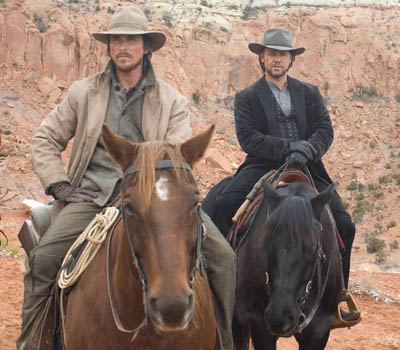
Mangold’s remake is a re-imagining of Daves’ film, more raw and unsparing. Both films give us the journey to town and a period of waiting in a hotel room. In the original, Daves treats the sequences in the hotel room as a chamber play. Each of Wade’s feints and thrusts gets a rise out of Evans until they’re finally forced onto the street to meet Wade’s gang and the train. Mangold has instead expanded the journey to the railway station, fleshing out the characters (especially Wade’s psychotic sidekick) and introducing new ones. This leaves less space for the hotel room scenes, which are I think the heart of Daves’ film.
At the level of imagery, the new version is firmly contemporary. The west is granitic; men are grizzled and weatherbeaten. When Wade and Evans get into the hotel room, Daves’ low-angle deep-focus compositions are replaced by the sort of brief singles that are common today. As in all Mangold’s work, minute shifts in eye behavior deepen the implications of the dialogue.
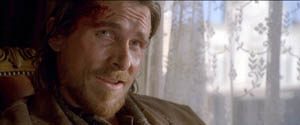
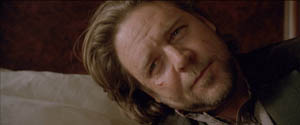
Similarly, the cutting, the speediest of any Mangold film, is in tune with contemporary pacing. At an average of 3 seconds per shot, it moves at twice the tempo of Daves’ original. Mangold has been reluctant to define himself by a self-conscious pictorial style. “I think writer-directors have less of a need sometimes to put a kind of obvious visual signature over and over again on their movies . . . . I don’t need to go through this kind of conscious effort to become the director who only uses 500mm lenses.” (2)
Mangold puts his trust in well-carpentered drama and nuanced performances. Daves begins his Yuma with Wade’s holdup of a stage, linking his movie to hallowed Western conventions, but Mangold anchors his drama in the family. His film begins and ends with Evans’ son Bill, who’s first shown reading a dime novel. We soon see his father, already tense and hollowed-out. At the end Mangold gives us a resolution that is more plausible than that of Leonard’s original or Daves’ version. What the new version loses by letting Evans’ wife Alice drop out of the plot it gains by shifting the dramatic weight to Bill in the final moments. The conclusion is drastically altered from the original, and it shocked me. But given Mangold’s admiration for the shadowlands of Sweet Smell, it makes sense.
In an interview Mangold remarks that Mackendrick distrusted film school because it stressed camera technique and didn’t prepare directors to work with actors. “It’s a giant distraction in film schools that in a way, by avoiding the world of the actor, young filmmakers are avoiding the most central relationship of their lives in the workplace.” (3) As we’d expect from Mangold’s other films, the central performances teem with details. Bale cuts up Crowe’s beefsteak, and Crowe gestures delicately with his manacles when he softly demands that the fat be trimmed. Bale’s gaunt, limping Evans, a Civil War casualty, becomes an almost spectral presence; his burning glances reveal a man oddly propelled into bravery by his failures. Crowe’s Ben Wade, for all his intelligence and jauntiness, is oddly unnerved by this farmer’s haunted demeanor. Actors and students of performance will be kept busy for years studying the two films and the way they illustrate different conceptions of the characters and the changes within mainstream cinema.
Sometimes I think that Hollywood’s motto is Tell simple stories with complex emotions. The classic studio tradition found elemental situations and used film technique and great performers to make sure that the plot was always clear. Yet this simplicity harbored a turbulent mixture of contrasting feelings, different registers and resonances, motifs invested with associations, sudden shifts between sentiment and humor. In his commitment to vivid storytelling and psychological nuances, Mangold has found a vigorous way to keep this tradition alive. Sandy would have been proud.
(1) James Mangold, “Afterword,” Clifford Odets and Ernest Lehman, Sweet Smell of Success (London: Faber, 1998), 165.
(2) Quoted in Stephan Littger, The Director’s Cut: Picturing Hollywood in the 21st Century (New York: Continuum, 2006), 317.
(3) Quoted in Littger, 313.
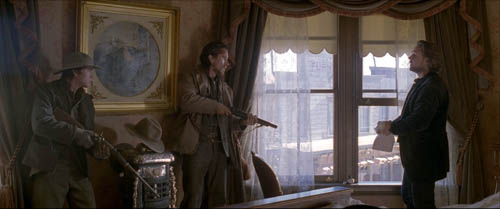
PS 9 Sept: Susan King’s article in the Los Angeles Times explains that Mangold first got acquainted with Daves’ film in Mackendrick’s class. “We would break down the dramatic structure of the film. This one really got under my skin, partly because it always really moved me. It also felt original in scope in that it was very claustrophobic and character-based.” King’s article gives valuable background on the difficulties of getting the film produced.













